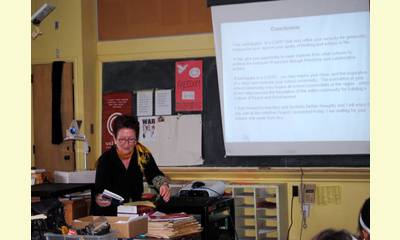|
|
Culture of Peace Presentation at Kitchener Collegiate Institute (Canada)
un articulo por Elisaveta Nica
I am working on the project “Student Culture of Peace and Development Centre” in Kitchener-Waterloo region (SCOPDC). In this position I gave a presentation on Culture of Peace and Development Initiative Project to the “One Earth Club” at Kitchener Collegiate Institute (KCI) on November 23, 2010.

click on photo to enlarge
I really appreciate the great support given to me by the Principal Lila Read, Marie Snyder, the Philosophy Teacher and Bill Bulmer, Head of the Geography Department.
My Power Point presentation was focused on debating the following questions:
How is a Culture of Peace defined by the United Nations and UNESCO?
What makes a Culture of Peace and Development Project unique and significant to KCI students, to secondary school communities and university students in the Kitchener Waterloo region?
In regards to the definition of a Culture of Peace, the presentation outlined key points of the “UN Declaration and Programme of Action on a Culture of Peace” adopted by the UN General Assembly on September 13, 1999 (see here for its contents.
In summary, we defined what makes the ”UN Declaration and Programme of Action on a Culture of Peace” unique and significant in history.
The UN COP is an advance in human thinking. Unlike other historical documents, such as the “Declaration of the Rights of Man and of the Citizen” (an outcome of the1789 French Revolution) and “The United States Declaration of Independence, “(an outcome of the 1776 American Revolution) that provided a foundation for the socio-economic, and political systems in France and the United States, but without addressing the status of woman and slavery, the UN COP is concerned with social justice and wellbeing of individuals and global communities, without gender or racial discrimination. The UNCOP takes the traditional peace concept to an innovative degree, by improving its content and applying it to the level of individuals, communities and nations.
I was delighted with the student’s feedback about the presentation and their attitude toward a ‘Culture of Peace and Development’ Club in the region. “I thought you provided valid information that I wasn’t previously aware of” mentioned one of the students. “I can bring my dedication and determination to help others both internationally and locally,” wrote another student. “Some of the students showed interest in a regional initiative, where they would be given the opportunity to get together with members of other schools to work on ‘peace specific’ ideas,” so Bill Bulmer wrote to me afterwards.
|








|
DISCUSSION
Pregunta(s) relacionada(s) al artículo :
What is the best way to teach peace to children?,
* * * * *
Comentario más reciente:
Maria Montessori believed that peace was innate within children. Her timeless educational philosophy was developed around this basic understanding. Perhaps all we need to do as teachers is to provide stimulating learning environments that validate this knowing and understanding and nurture it. We may not have to actually teach it, Sharing peace-building stories gently attends to this. Strong, creative and imaginative peace-building characters who focus upon win-win and have faith in peace being possible are at the centre of the story plots. In Hassaun Ali-Jones Bey's (Boundless Gratitude http://boundlessgratitude.com/products.html ) unique and mesmerising story, Black Ink is such a character who bravely crosses the universe seeking validation of what he knows in his heart. The magical character also models all the important peace-building values, understandings and actions needed for peace-building. I believe also that peace-building must be modelled and the whole teaching-learning environment should reflect similar values, understandings and actions...as is the primary focus of the Save the Children Australia UN Global Peace School Program upon which I am presently fortunate to be working. . ... continuación.

|
|









